Printech Park Cluster in Bengaluru: Finding the print strength - The Noel D'Cunha Sunday Column
In 2008, the Karnataka State Printers Association set out to put an affordable plan for the print industry in the state. By setting up the Printech Park Cluster (PPC), and the Common Facility Centre on the outskirts of Bengaluru, it has succeeded in investing and extending the print sector a comparative advantage.
In this Sunday Column, we discuss what went behind the setting up of the Printech Park Cluster
06 Mar 2022 | By Noel D'Cunha
It was in 2006. Talks of industrial parks and technology parks were doing the rounds. It also sparked the interest of CR Janardhana. “When other industries were talking about industrial parks and technology parks, why should the printing industry not have one such park,” he thought.
CR Jarnadhana is the past president of AIFMP, Karnataka Small Scale Industries Association (KASSIA) and Karnataka State Printers Association (KSPA). KSPA discussed and approached the state government of Karnataka with a proposal of setting up a print cluster in Bengaluru. “There was the initial reluctance because lack of information on how the printing industry functions, perhaps, the notion that the printing industry does not need such type of infrastructure,” Jarnadhana says.
The KSPA is an association that was initiated in 1941, a few years before India’s independence. In those days, the British government were against setting up any form of association, more so for printing companies or the press. “And if they did, permissions were given subject to the associations giving a declaration in the court of law that they will not print or involve in anti-government activities,” says Janardhana. KSPA completed all the required formalities and was registered in 1942.
In 1966, KSPA completed 25 years and in 1993, its golden jubilee. Today it is an 80-year-old organisation.
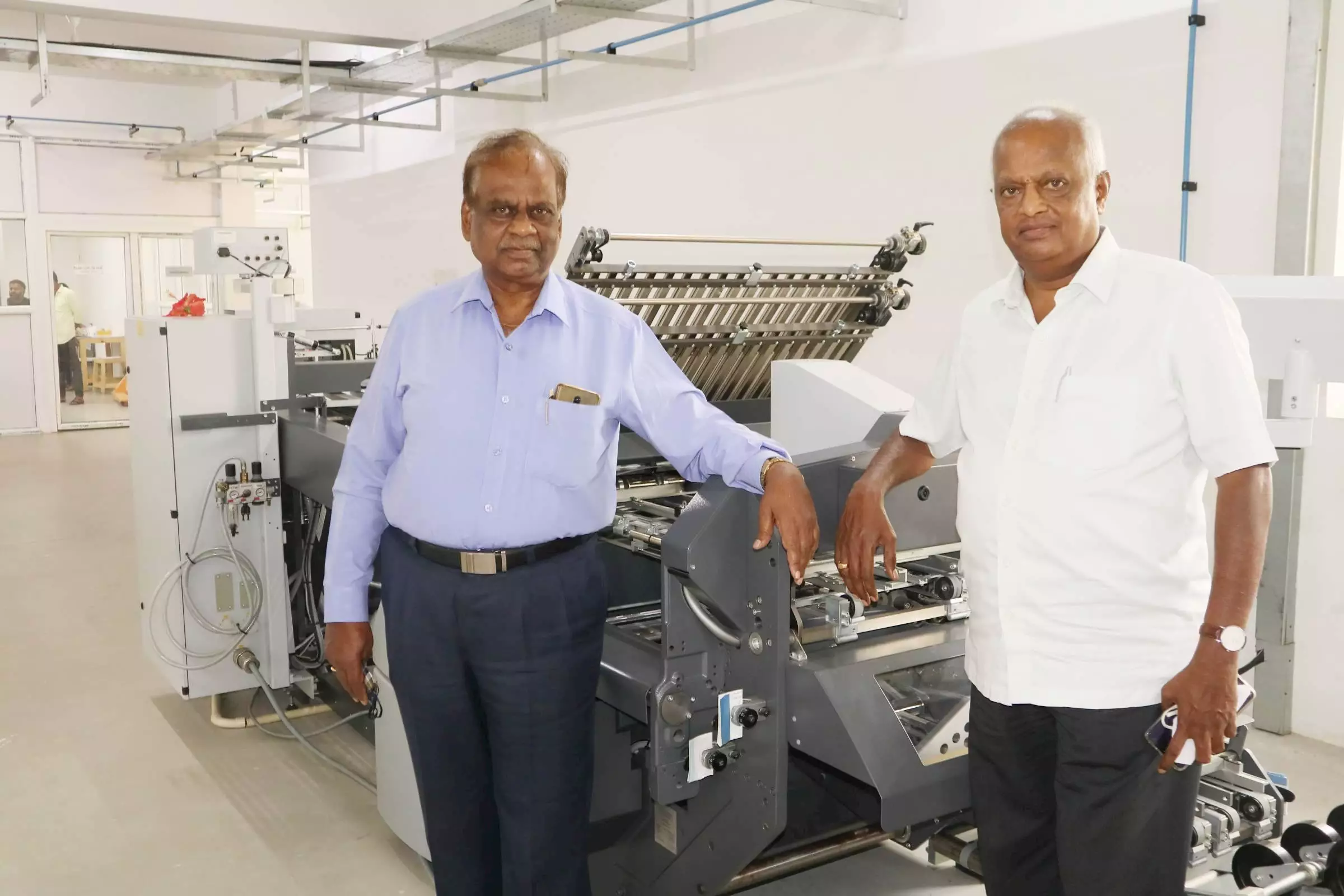
(l-r) Janardhana and BR Ashok Kumar with the Stahlfolder machine
Coming back to the cluster discussion, Janardhana informs that the Karnataka state government had acquired 3,000 acres in Harohalli, a rural area on the outskirts of Bengaluru. The KSPA members made the government aware of how the printing industry is interlinked with every other industry and its importance to products and services that manufacturers bring to the market.
“After our explanation, the state government was convinced, and in 2008, allotted 57 acres for the proposed cluster, where common industries doing similar work will set up plants,” says Janardhana.
The idea of setting up similar companies in a centralised place is to stimulate economic growth. “The object of the cluster is to make production cheaper. Printing activities are divided into three parts, pre-press, press and post-press. One print company cannot install all types of machines, so the cluster serves as a common platform where members of all the three printing departments would be operating, and engage each other to produce the final print product that the buyer needs,” explains Janardhana.
And it works.
After the development of roads and mapping of plots, the proposed Print Tech Cluster (PPC) was ready for allotment in 2010 in the Harohalli Industrial Estate. A total of 92 plots – 24 with one acre, 15 with half an acre, and the remaining 53 as quarter-acre plots were mapped.
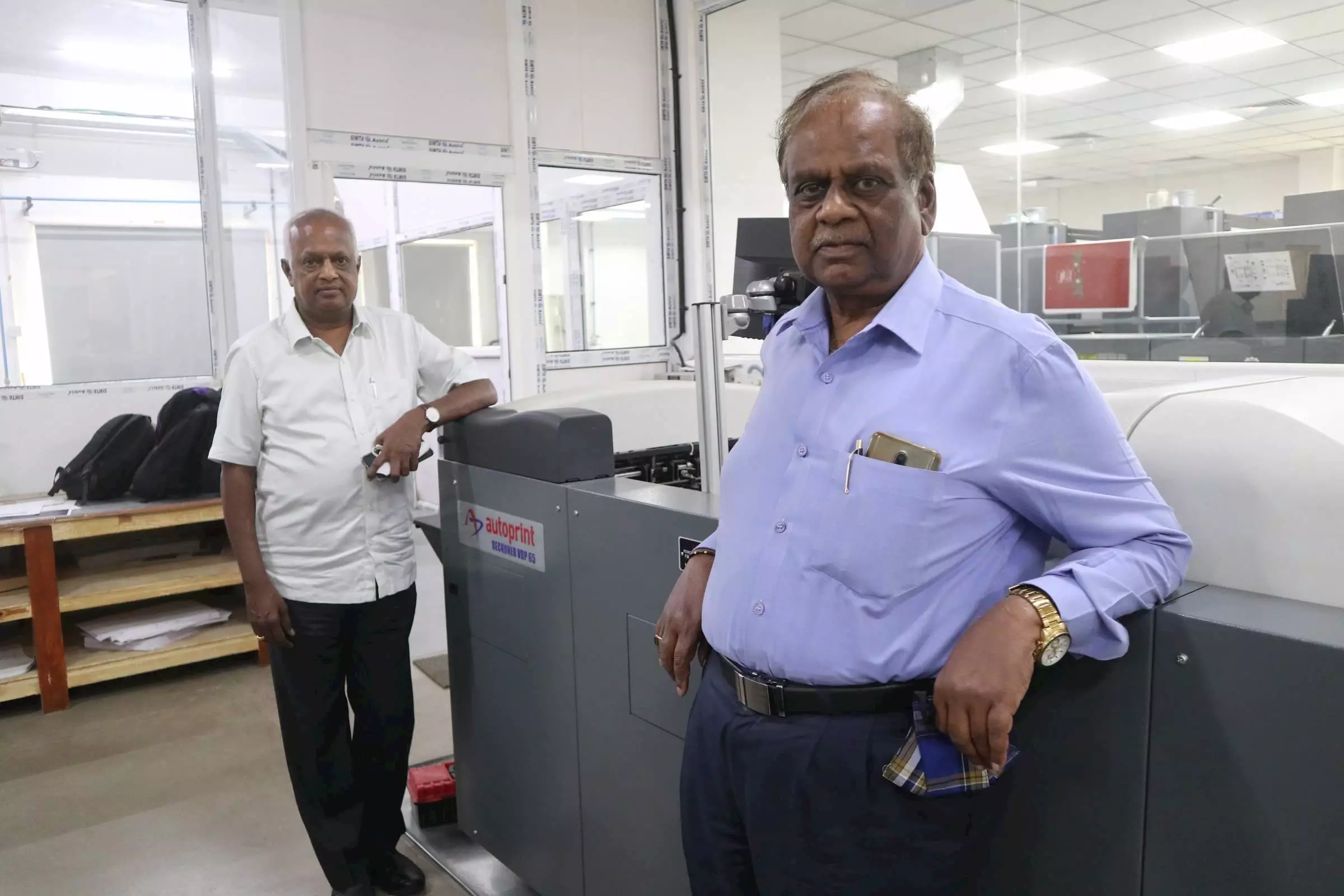
(l-r) BR Ashok Kumar and Janardhana with the Autoprint kit
When PrintWeek team visited the PPC in the Harohalli Industrial Estate, it noticed a number of print companies, big and small. Among them, the print companies the team visited were Sukee Print Pack, one of the first to set up a print factory, Nice Print, and Innova Packaging.
The Sukee factory is spread across a 1,60,000 sqft campus and is one of the premier printing houses in Bengaluru, specialising in high-quality sheetfed offset printing and packaging. Innova made the move to Harohalli in 2019 with a 45,000 sqft specifically constructed to utilise space in the best manner. Equipped with two Mitsubishi presses, a four- and a six-colour, the company added a Bobst Novacut die-cutter in 2019, and very recently a Bobst Ambition 106 A2 folder-gluer. Nice on the other hand operates on a 32,000 sqft plant and converts 120 tonnes of paperboard and 20-25 tonnes of paper per month.
Clusters fuel economy
Janardhana cites a study by MIT in the USA that showed that clusters of almost all kinds help drive overall economic growth in multiple ways. That study said clusters of almost all kinds help drive overall economic growth in multiple ways, from job creation and development of the intellectual property to the formation of new industries.
Out of the 92 plots, 76 have been allotted. 16 plots facing legal issues are yet to be cleared, hence have not been allotted. Of the 76 allotted plots, 42 plants have become functional, while 32 plants are under construction and hopefully will be operational in the next 12 months.
Janardhana says that once the entire cluster is operational, there will be employment opportunities. “We expect that about 6,000 people will get direct and indirect employment from this cluster.” He adds, “The Karnataka government gave KSPA the 52-acre land at Rs 20-crore, once the cluster with all the 92 units become operational, the state and central government, will fetch GST of over Rs 20-crore per annum. That the minimum.”
Can a print business buy more than one plot, if someone wants to? “If the government provides KSPA land, we will certainly want to. We have requested the government to grant us additional 50-acre land. The conversation is on,” says Janardhana.
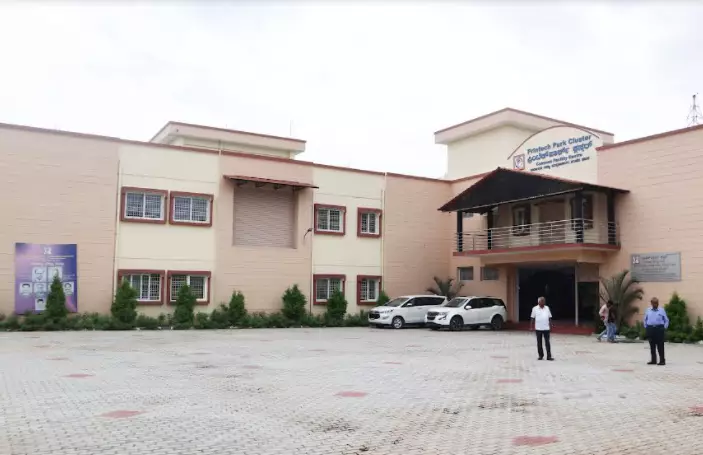
PPC Common Facility Centre
The Government of India has an MSME scheme – Industrial Infrastructure Development Scheme (IIDS) under which interested parties can apply for grants to set up a plant. KSPA was eligible to apply for the grant, which has three finance components – contributions from the state government, the applicant and the central government. The applicant’s contribution is 15% of the total project cost.
The KSPA utilised the scheme to set up a Common Facility Centre with the PPC, investing in and combining pre-press, press and post-press activities. “The idea is to protect the investment the print companies in the cluster by providing support in any of the departments they may not possess,” says Janardhana.
The PPC Common Facility Centre, as an organisation is for the use of cluster members within the 57 acres as well as non-cluster members. So, printers across the 31 districts of Karnataka are eligible to utilise the facilities of this organisation, regardless of membership status with KSPA. However, preference is given to the members in the cluster.
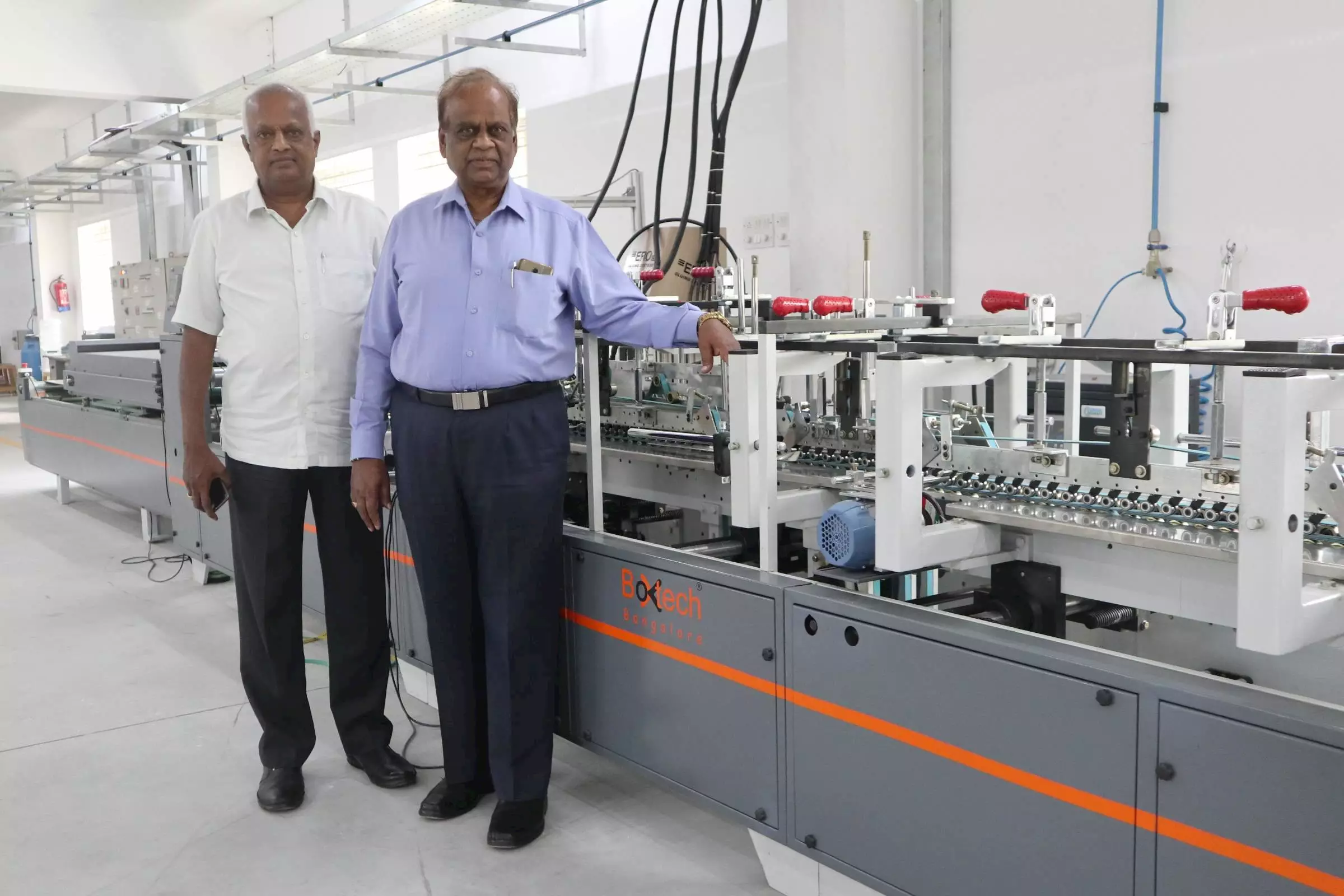
(l-r) BR Ashok Kumar and Janardhana with the Boxtech kit
The president of KSPA, BR Ashok Kumar, has formed a PPC Common Facility Centre Coordination Committee comprising members of all the 31 districts, which shares the information about the PPC Common Facility Centre's functioning. The Centre has the capacity to carry out functions, right from procurement of raw material to transportation of the finished product. “The entire printing process can be carried out at the centre, and the finished product despatched to the destination once the final artwork is approved,” informs Janardhana. “Further depending on the creditworthiness of the printer wishing to avail the Centre’s facility, the Centre’s management can even extend limited credit period too,” says Janardhana.
What are the benefit of the PPC Centre to the printer and allied service providers within the cluster? It can provide proofing services, and print them if required. Janardhana explains, “For example, a print buyer has fixed a print company to provide printing and packaging service. In such a case, that print company can deliver service within its production capacity. If there are jobs, which that the print company is not able to manage within its production capacity, those jobs can be carried out at the Centre. The Centre will fulfil that printer’s commitment to its print buyer. The Centre will bill the print company, which will then further bill its customer. Doing the job at the Centre will have the benefit of the lower production cost, and the ability to serve the customer in time.”
The Heidelberg support
In 1997, Janardhana says that the KSPA hosted an international exhibition where Heidelberg showcased a brand new four-colour GTO machine, which give the Karnataka printers a glimpse of the power of Heidelberg’s technology and four-colour printing. “That’s when the partnership began,” says Janardhana.
The idea of the Cluster was to have quality machines so that those printers who are seeking help can be provided with quality print services. For example, if a printer has a certain press that cannot run paper or paperboard of 250gsm or 400gsm, in such cases it will have to outsource the requirement. “Keeping that in mind, we opted for an international standard machine, and that’s how Heidelberg came into the picture. The technical committee approved our recommendation of opting for Heidelberg.
The Centre invested in Heidelberg Speedmaster CS 92, capable of printing both commercial and packaging jobs; a Suprasetter CTP; a Polar cutting machine; and Stahl folding machine. However, the purchase was not a direct one. There was a tendering process involved.
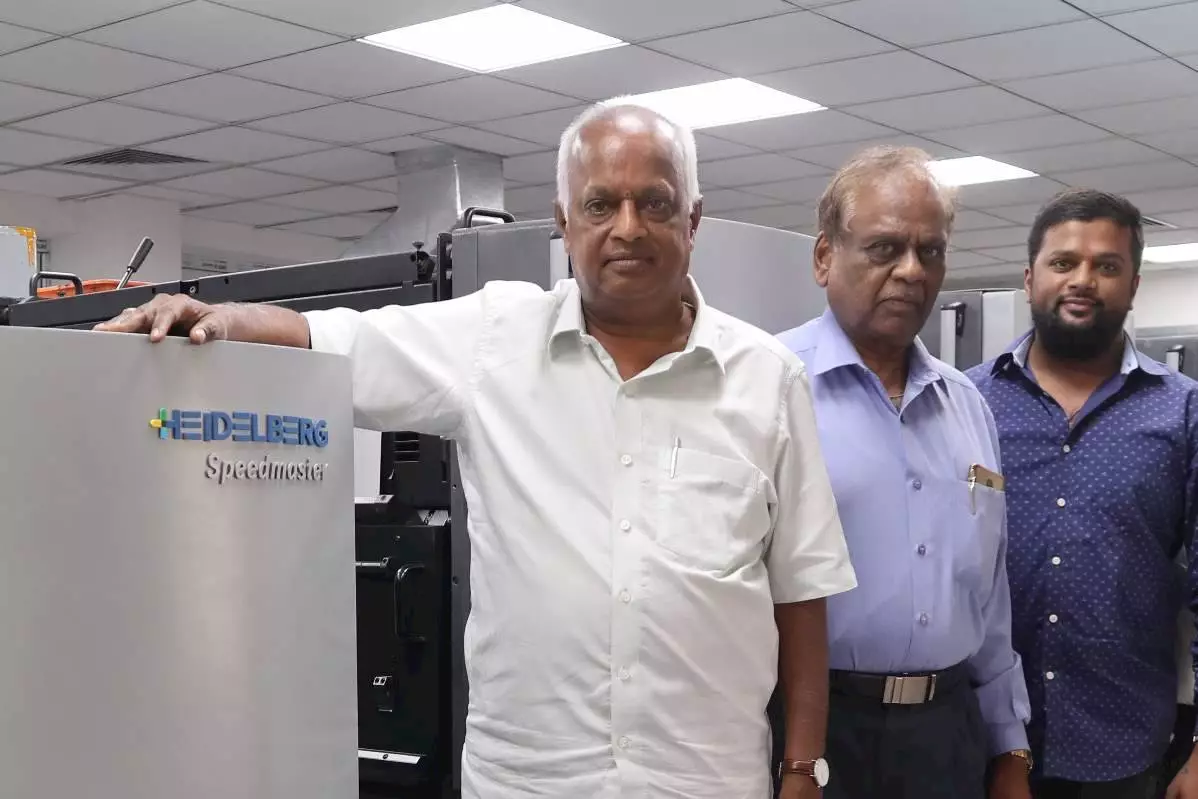
(l-r) BR Ashok Kumar, Janardhana (l) and Common Facility Centre colleague with the Heidelberg Speedmaster press
The government of Karnataka under the advice of the government of India formed a technical committee comprising the managing director of Karnataka Council of Technology Upgradation (KCTU) as the chairman of the committee, two members from the KSPA (myself and the president of KSPA), and three members from the government of Karnataka, of which one was from the MSME and one technical person. The members asked the cluster management to justify the need and necessity, which was provided with supportive documents. “The government procedures required any purchase be brand new. Buying secondhand machines was not allowed,” says Janardhana.
The Centre also invested in locally manufactured equipment like Boxtech’s folder-gluer, Autoprint Reckenor VDP 65 and Excel Machinery’s Maxima die-cutter.
Surviving the Covid pandemic
The Centre got financial support for the purchase of equipment under the IIDS scheme. The scheme, however, does not have a provision for working capital. “And without working capital, one cannot run an organisation. But with the support of the parent body (KSPA), we were able to collect a working capital fund of Rs one-crore,” says Janardhana.
While the PPC Common Facility Centre managed to stay operational, other printers who did not have the financial backing had a bad time. KSPA has around 600 members, and all are still operating. Karnataka as a state has about 15,000 printers spread across 31 districts, of which 600 are KSPA members.
“Since March 2020, there have been two waves, and two lockdowns, which has hit many small print companies. The KSPA members have survived. However, in my opinion, around 20% of the other print companies in Karnataka have shut shop.”

(l-r) BR Ashok Kumar, Janardhana with Excel's Maxima die-cutter
Janardhana is also of the opinion that those print companies who have shut shop will not return to the fold. “There’s consolidation happening, and the fittest will survive, and those who survive will be in a position to take up the jobs now left open due to the closure of print shops who could not survive.”


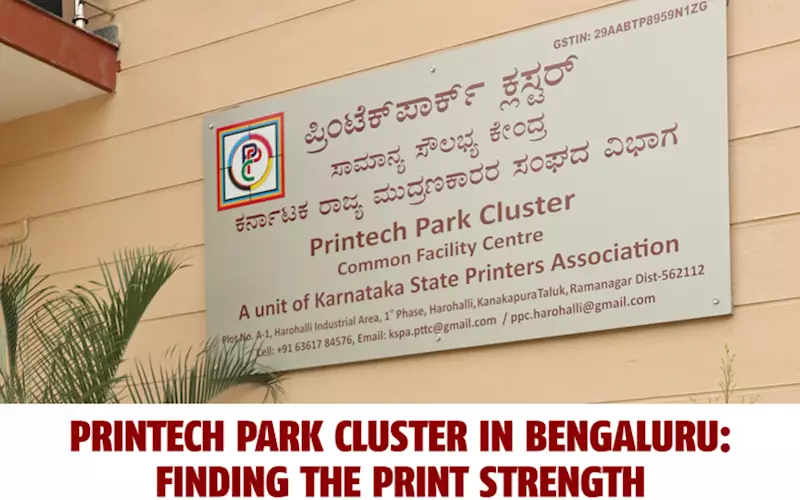








 See All
See All